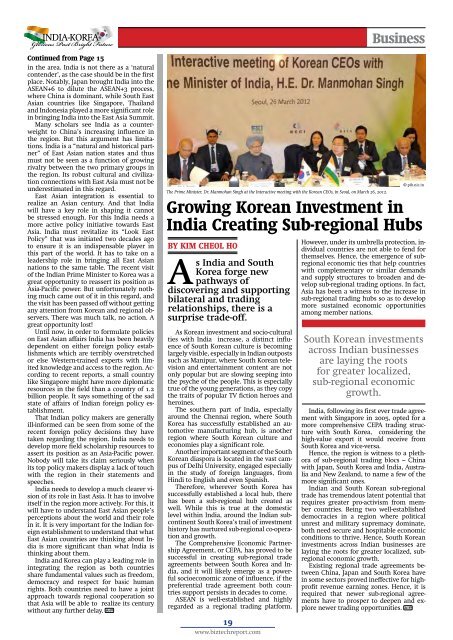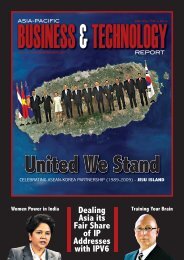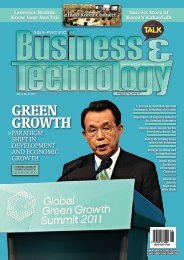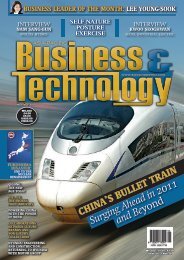INDIA-KOREA - Asia-Pacific Business and Technology Report
INDIA-KOREA - Asia-Pacific Business and Technology Report
INDIA-KOREA - Asia-Pacific Business and Technology Report
Create successful ePaper yourself
Turn your PDF publications into a flip-book with our unique Google optimized e-Paper software.
<strong>INDIA</strong>-<strong>KOREA</strong><br />
Glorious Past Bright Future<br />
Continued from Page 15<br />
in the area. India is not there as a ‘natural<br />
contender’, as the case should be in the first<br />
place. Notably, Japan brought India into the<br />
ASEAN+6 to dilute the ASEAN+3 process,<br />
where China is dominant, while South East<br />
<strong>Asia</strong>n countries like Singapore, Thail<strong>and</strong><br />
<strong>and</strong> Indonesia played a more significant role<br />
in bringing India into the East <strong>Asia</strong> Summit.<br />
Many scholars see India as a counterweight<br />
to China’s increasing influence in<br />
the region. But this argument has limitations.<br />
India is a “natural <strong>and</strong> historical partner”<br />
of East <strong>Asia</strong>n nation states <strong>and</strong> thus<br />
must not be seen as a function of growing<br />
rivalry between the two primary groups in<br />
the region. Its robust cultural <strong>and</strong> civilization<br />
connections with East <strong>Asia</strong> must not be<br />
underestimated in this regard.<br />
East <strong>Asia</strong>n integration is essential to<br />
realize an <strong>Asia</strong>n century. And that India<br />
will have a key role in shaping it cannot<br />
be stressed enough. For this India needs a<br />
more active policy initiative towards East<br />
<strong>Asia</strong>. India must revitalize its “Look East<br />
Policy” that was initiated two decades ago<br />
to ensure it is an indispensable player in<br />
this part of the world. It has to take on a<br />
leadership role in bringing all East <strong>Asia</strong>n<br />
nations to the same table. The recent visit<br />
of the Indian Prime Minister to Korea was a<br />
great opportunity to reassert its position as<br />
<strong>Asia</strong>-<strong>Pacific</strong> power. But unfortunately nothing<br />
much came out of it in this regard, <strong>and</strong><br />
the visit has been passed off without getting<br />
any attention from Korean <strong>and</strong> regional observers.<br />
There was much talk, no action. A<br />
great opportunity lost!<br />
Until now, in order to formulate policies<br />
on East <strong>Asia</strong>n affairs India has been heavily<br />
dependent on either foreign policy establishments<br />
which are terribly overstretched<br />
or else Western-trained experts with limited<br />
knowledge <strong>and</strong> access to the region. According<br />
to recent reports, a small country<br />
like Singapore might have more diplomatic<br />
resources in the field than a country of 1.2<br />
billion people. It says something of the sad<br />
state of affairs of Indian foreign policy establishment.<br />
That Indian policy makers are generally<br />
ill-informed can be seen from some of the<br />
recent foreign policy decisions they have<br />
taken regarding the region. India needs to<br />
develop more field scholarship resources to<br />
assert its position as an <strong>Asia</strong>-<strong>Pacific</strong> power.<br />
Nobody will take its claim seriously when<br />
its top policy makers display a lack of touch<br />
with the region in their statements <strong>and</strong><br />
speeches.<br />
India needs to develop a much clearer vision<br />
of its role in East <strong>Asia</strong>. It has to involve<br />
itself in the region more actively. For this, it<br />
will have to underst<strong>and</strong> East <strong>Asia</strong>n people’s<br />
perceptions about the world <strong>and</strong> their role<br />
in it. It is very important for the Indian foreign<br />
establishment to underst<strong>and</strong> that what<br />
East <strong>Asia</strong>n countries are thinking about India<br />
is more significant than what India is<br />
thinking about them.<br />
India <strong>and</strong> Korea can play a leading role in<br />
integrating the region as both countries<br />
share fundamental values such as freedom,<br />
democracy <strong>and</strong> respect for basic human<br />
rights. Both countries need to have a joint<br />
approach towards regional cooperation so<br />
that <strong>Asia</strong> will be able to realize its century<br />
without any further delay. A-P<br />
The Prime Minister, Dr. Manmohan Singh at the Interactive meeting with the Korean CEOs, in Seoul, on March 26, 2012.<br />
19<br />
www.biztechreport.com<br />
<strong>Business</strong><br />
Growing Korean Investment in<br />
India Creating Sub-regional Hubs<br />
by Kim Cheol Ho<br />
As India <strong>and</strong> South<br />
Korea forge new<br />
pathways of<br />
discovering <strong>and</strong> supporting<br />
bilateral <strong>and</strong> trading<br />
relationships, there is a<br />
surprise trade-off.<br />
As Korean investment <strong>and</strong> socio-cultural<br />
ties with India increase, a distinct influence<br />
of South Korean culture is becoming<br />
largely visible, especially in Indian outposts<br />
such as Manipur, where South Korean television<br />
<strong>and</strong> entertainment content are not<br />
only popular but are slowing seeping into<br />
the psyche of the people. This is especially<br />
true of the young generations, as they copy<br />
the traits of popular TV fiction heroes <strong>and</strong><br />
heroines.<br />
The southern part of India, especially<br />
around the Chennai region, where South<br />
Korea has successfully established an automotive<br />
manufacturing hub, is another<br />
region where South Korean culture <strong>and</strong><br />
economies play a significant role.<br />
Another important segment of the South<br />
Korean diaspora is located in the vast campus<br />
of Delhi University, engaged especially<br />
in the study of foreign languages, from<br />
Hindi to English <strong>and</strong> even Spanish.<br />
Therefore, wherever South Korea has<br />
successfully established a local hub, there<br />
has been a sub-regional hub created as<br />
well. While this is true at the domestic<br />
level within India, around the Indian subcontinent<br />
South Korea’s trail of investment<br />
history has nurtured sub-regional co-operation<br />
<strong>and</strong> growth.<br />
The Comprehensive Economic Partnership<br />
Agreement, or CEPA, has proved to be<br />
successful in creating sub-regional trade<br />
agreements between South Korea <strong>and</strong> India,<br />
<strong>and</strong> it will likely emerge as a powerful<br />
socioeconomic zone of influence, if the<br />
preferential trade agreement both countries<br />
support persists in decades to come.<br />
ASEAN is well-established <strong>and</strong> highly<br />
regarded as a regional trading platform.<br />
© pib.nic.in<br />
However, under its umbrella protection, individual<br />
countries are not able to fend for<br />
themselves. Hence, the emergence of subregional<br />
economic ties that help countries<br />
with complementary or similar dem<strong>and</strong>s<br />
<strong>and</strong> supply structures to broaden <strong>and</strong> develop<br />
sub-regional trading options. In fact,<br />
<strong>Asia</strong> has been a witness to the increase in<br />
sub-regional trading hubs so as to develop<br />
more sustained economic opportunities<br />
among member nations.<br />
South Korean investments<br />
across Indian businesses<br />
are laying the roots<br />
for greater localized,<br />
sub-regional economic<br />
growth.<br />
India, following its first ever trade agreement<br />
with Singapore in 2005, opted for a<br />
more comprehensive CEPA trading structure<br />
with South Korea, considering the<br />
high-value export it would receive from<br />
South Korea <strong>and</strong> vice-versa.<br />
Hence, the region is witness to a plethora<br />
of sub-regional trading blocs – China<br />
with Japan, South Korea <strong>and</strong> India, Australia<br />
<strong>and</strong> New Zeal<strong>and</strong>, to name a few of the<br />
more significant ones.<br />
Indian <strong>and</strong> South Korean sub-regional<br />
trade has tremendous latent potential that<br />
requires greater pro-activism from member<br />
countries. Being two well-established<br />
democracies in a region where political<br />
unrest <strong>and</strong> military supremacy dominate,<br />
both need secure <strong>and</strong> hospitable economic<br />
conditions to thrive. Hence, South Korean<br />
investments across Indian businesses are<br />
laying the roots for greater localized, subregional<br />
economic growth.<br />
Existing regional trade agreements between<br />
China, Japan <strong>and</strong> South Korea have<br />
in some sectors proved ineffective for highprofit<br />
revenue earning zones. Hence, it is<br />
required that newer sub-regional agreements<br />
have to prosper to deepen <strong>and</strong> explore<br />
newer trading opportunities. A-P









